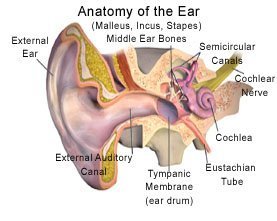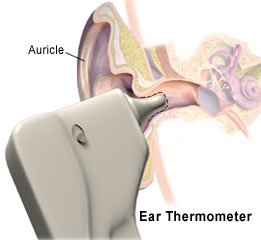How to Take an Ear Temperature
Medically reviewed by Drugs.com. Last updated on Feb 20, 2025.
What is it?
An ear temperature (TEM-per-ah-chur) is also known as a tympanic (tim-PAN-ik) membrane temperature. The tympanic membrane is also known as the "ear drum". This is a way of measuring your body temperature inside your ear. It only takes a few seconds to check an ear temperature. Children may like this way of checking their temperature because it is so quick.
 |
Why do I need to check a tympanic temperature?
You may need to check an ear temperature to learn if you or a family member have a fever. "Fever" is a word used for a temperature that is higher than normal for your body. Fever may be a sign of illness, infection, or other conditions. The normal ear temperature for adults is 99.5° F (37.5° C).
What kind of thermometer is used to take an ear temperature?
An ear thermometer is a hand-held device with a "window" showing the temperature. You can buy these thermometers at grocery, drug, or medical supply stores.
When should I NOT use an ear thermometer?
- Ear thermometers will give you an incorrect and low reading if there is "wax" in the ear of the person having their temperature checked. Before using an ear thermometer at home, have your caregiver check the ears of the person needing their temperature checked. People normally have some wax in their ears. If there is too much wax to check an ear temperature, a health professional (nurse, doctor) may need to remove some of it. Do not try to remove wax from inside your own or someone else's ears. This may damage hearing and cause pain.
- Do not use an ear thermometer when a person has a sore ear, an ear infection, or if they just had ear surgery.
How do I use an ear thermometer?
There are many kinds of ear thermometers. Carefully read the instructions before using your thermometer. The following steps may help you use your ear thermometer:
- Take the thermometer out of its holder.
- Put a new, throw-away cover over the tip of the thermometer.
- Hold your child's head so it does not move, or tell the person not to move his head.
- If you are checking a child's temperature, gently pull the child's ear straight back. For an adult, gently pull the ear up and then back.

- Put the covered tip into the ear opening. Do not use force or push hard. The thermometer tip should not touch the ear drum.
- Press the button to turn on the thermometer.
- Hold the button until the thermometer beeps, or follow the instructions for your thermometer.
- Remove the thermometer from the ear opening.
- The temperature will show up in the "window".
- Your caregiver may want you to keep a temperature record. Write down the time and the temperature each time you take it.
- Remove and discard the throw-away cover.
- Place the thermometer back into the holder.
Care Agreement
You have the right to help plan your care. To help with this plan, you must learn how to take a temperature in the ear. You can then discuss your treatment options with your caregiver. You can work with caregivers to decide what care will be used to treat you. You always have the right to refuse treatment.
The above information is an educational aid only. It is not intended as medical advice for individual conditions or treatments. Talk to your doctor, nurse or pharmacist before following any medical regimen to see if it is safe and effective for you.
Further information
Always consult your healthcare provider to ensure the information displayed on this page applies to your personal circumstances.
Copyright © 2012. Thomson Reuters. All rights reserved. Information is for End User's use only and may not be sold, redistributed or otherwise used for commercial purposes.
